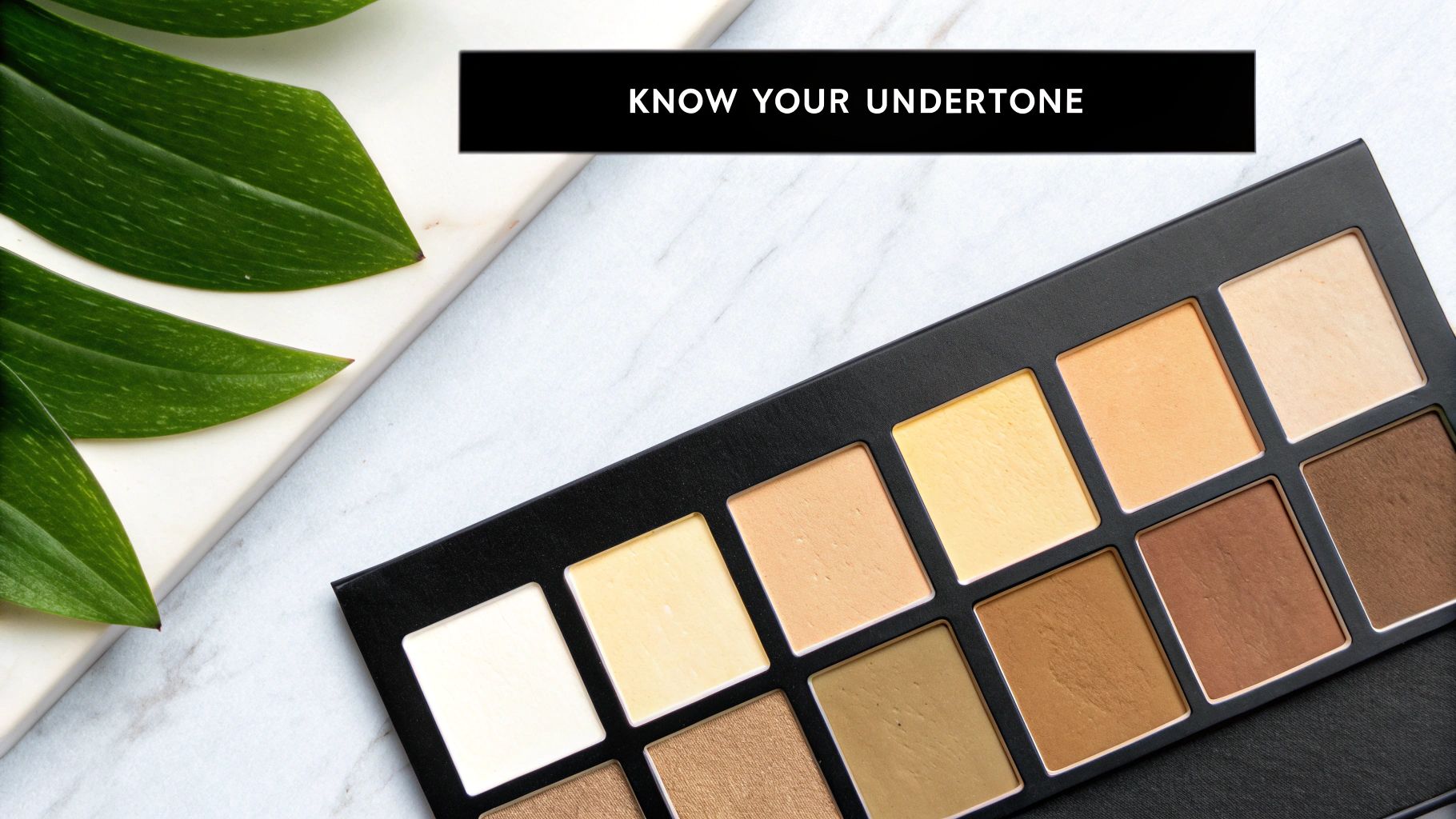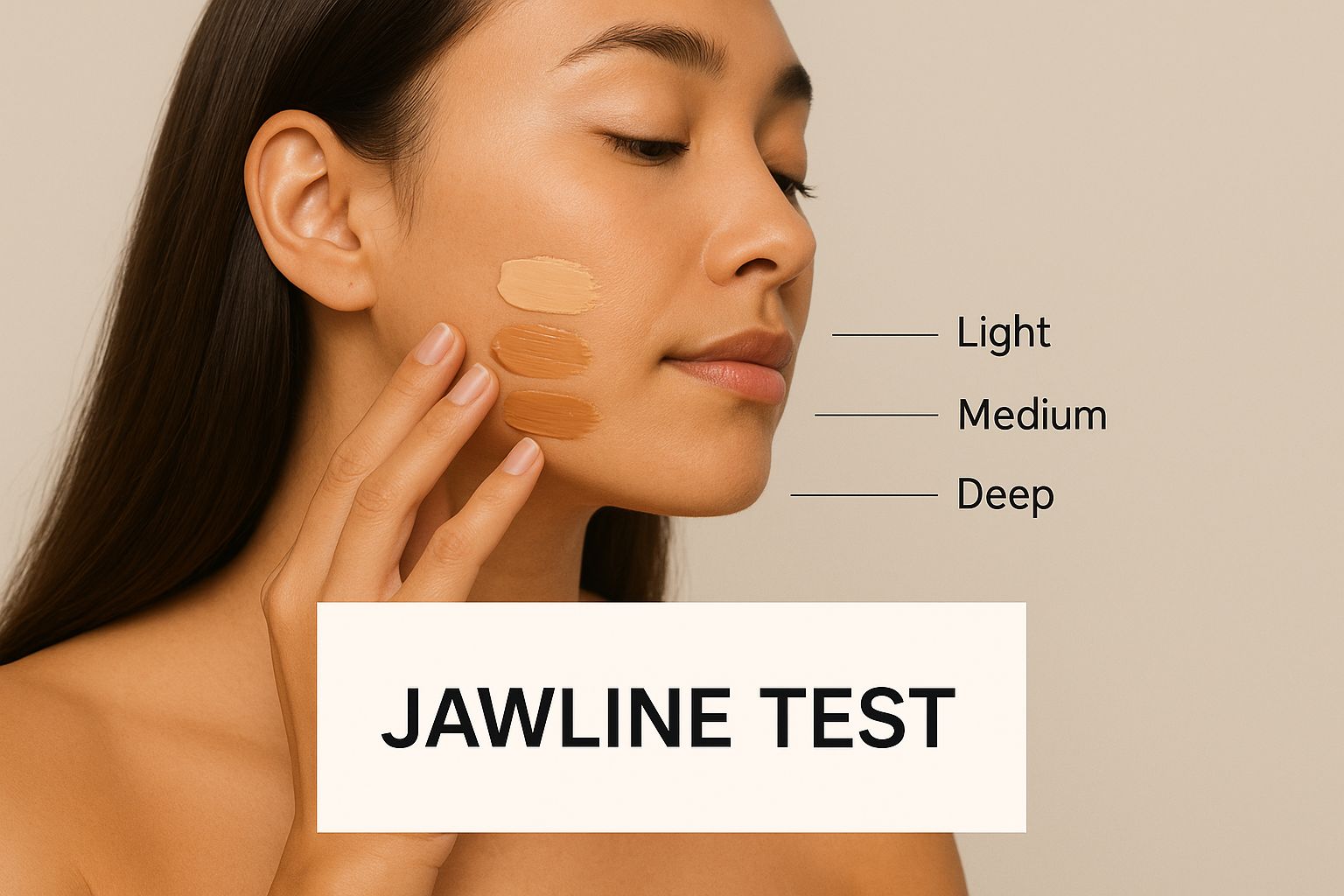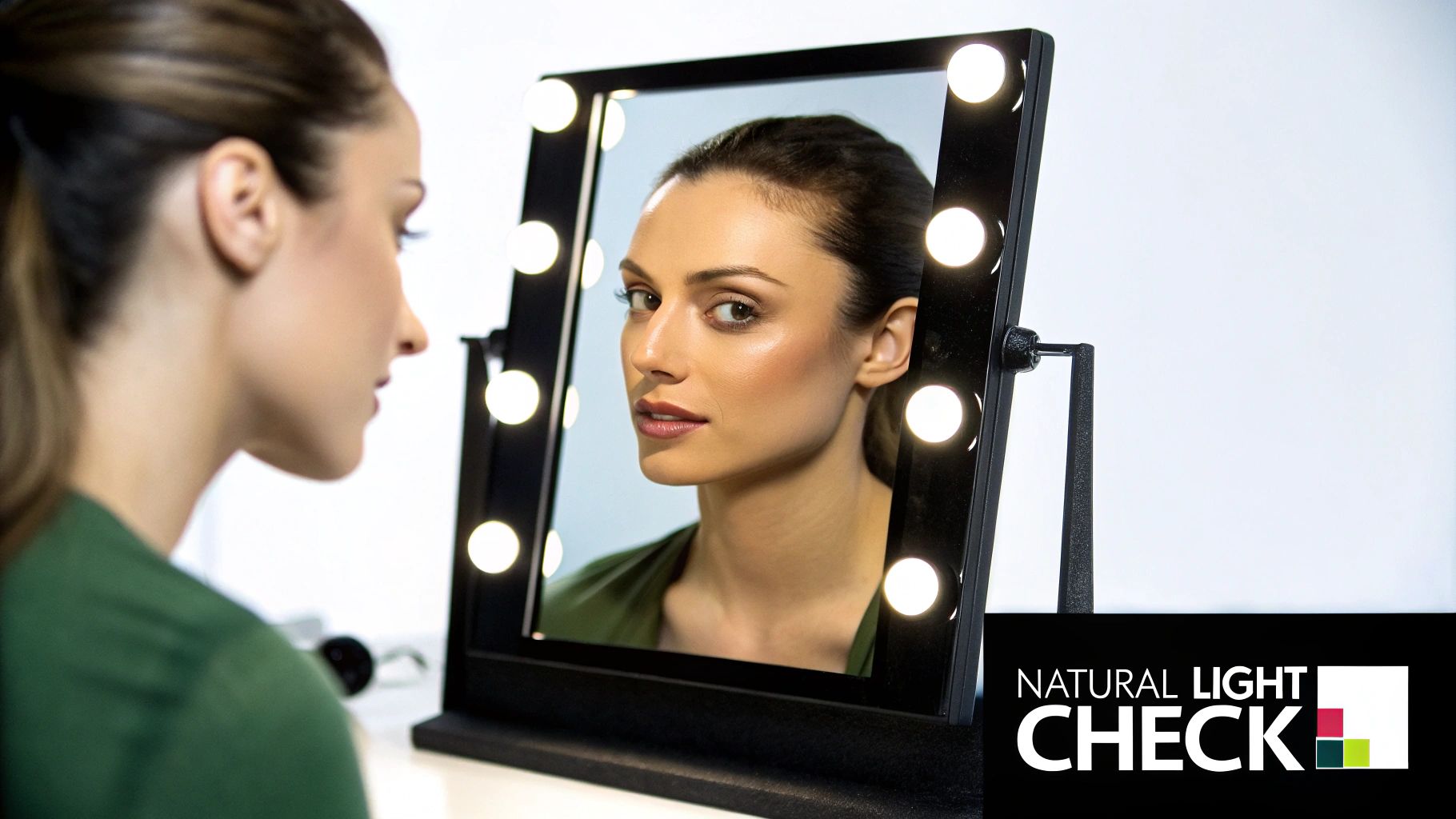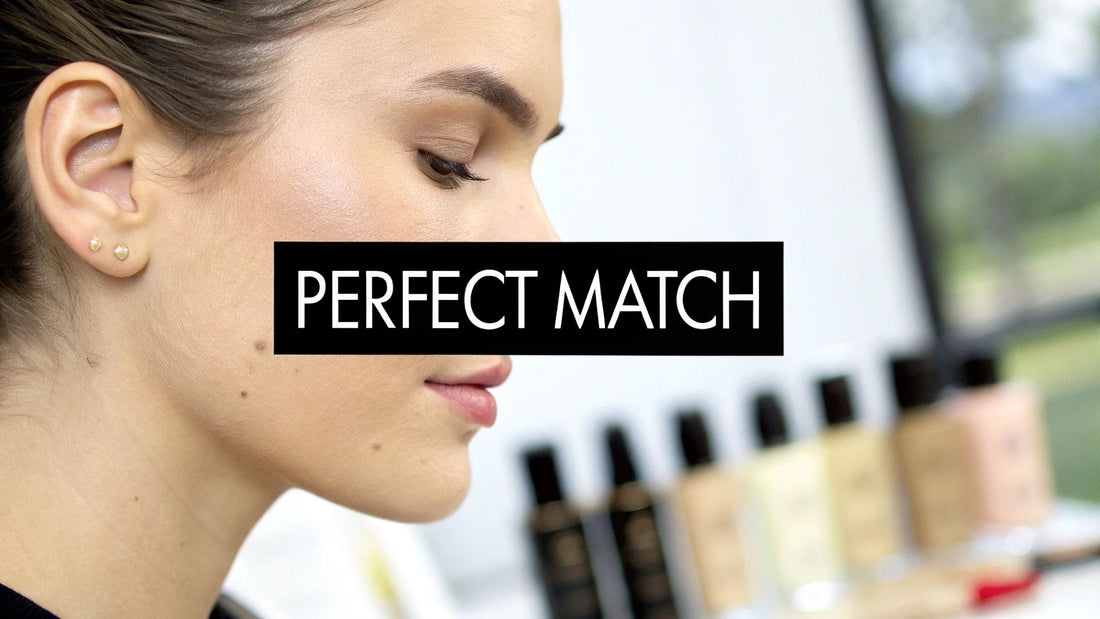Finding the perfect foundation shade is all about making it look like you're not wearing any at all. The goal is a color that just melts into your skin, which starts with figuring out your undertone and always, always testing shades in natural light. And please, forget swatching on your wrist—the only place that truly matters is your jawline, where your face meets your neck.
Why Finding Your Perfect Foundation Match Feels Impossible

We've all been there. You spend ages in the store, meticulously comparing swatches, and finally walk out with a bottle you’re convinced is "the one." Then you get home, look in your own mirror, and realize it's completely wrong. The color is off, it looks like a mask, and the frustration is just overwhelming.
If that story sounds familiar, you're in good company. This struggle is incredibly common, especially for those of us in Canada dealing with dramatic seasonal shifts and the different light that comes with them.
It's not just a feeling, either. Research shows that while nearly 99% of people who wear foundation say the right shade is a top priority, the average person ends up buying 2.4 different shades of the same foundation just to get a decent match. That stat from consumer trend experts at Ipsos highlights a huge disconnect between what we need and what’s actually easy to find on the shelf at Canadian retailers.
The Three Pillars of Foundation Success
So, how do you finally break this expensive cycle of buying and returning? The secret isn't some magical, one-size-fits-all product. It's about mastering a simple, repeatable process that puts you in control. It boils down to three core pillars that will completely change the way you shop for foundation.
- Nailing Your True Undertone: This is that subtle, underlying color beneath your skin's surface that doesn't change with a tan or a flush. Getting this right is non-negotiable—it's the most critical step.
- Testing in the Right Light: The harsh, artificial lighting in most stores is your worst enemy. It distorts color. Natural daylight is the only reliable way to see what a shade truly looks like on your skin.
- Choosing the Right Formula and Application: Even a perfect color match can look 'off' if the formula fights with your skin type or if you apply it the wrong way.
Finding your holy grail foundation is less about the brand name and more about your method. Once you learn to read what your skin actually needs, you can shop anywhere with total confidence.
This guide is here to give you that confidence. We’ll walk through each of these pillars with practical, real-world advice. You'll learn simple tricks to finally decode your undertone and get pro tips on how to swatch and select a formula that works for you. If you're ready to dive in, our guide on how to choose the right foundation is a great starting point. It's time to stop guessing and start finding the foundation that truly looks and feels like a second skin.
Confidently Decode Your Skin's Undertone
The real secret to finding a foundation that looks like a second skin has nothing to do with shade names like 'ivory' or 'beige.' It’s all about understanding the subtle, underlying hue of your skin—your undertone. This is the color that’s always there, whether you’re flushed from a workout or have a bit of a tan, making it the most reliable guide you have.
Nailing this one concept is the single most important step you can take to end the frustrating cycle of buying foundations that just look off. The global market for facial products, including foundation, was valued at a staggering USD 68.74 billion in 2023. Knowing your undertone is how you make sure your money is well spent.
Simple Tests To Find Your Undertone
You don't need to be a professional makeup artist to figure this out. In fact, you can get a pretty clear idea right now with a few time-tested tricks.
-
The Vein Test: This is the classic method for a reason. Take a look at the veins on the inside of your wrist in good, natural daylight. If they look distinctly blue or purplish, you almost certainly have a cool undertone. If they appear more greenish, you’re in the warm undertone family. See a bit of both? You’re likely neutral.
-
The Jewelry Test: Think about which metals make your skin truly come alive. If silver and platinum give you a bright, vibrant look, you’re probably on the cool side. But if gold makes you glow, you lean warm. If you can pull off both without a second thought, you’re probably neutral.
-
The Sun Test: How does your skin typically react to sun exposure? If you tend to burn easily and turn pink before (or instead of) tanning, you’re likely cool-toned. If you tan easily, developing a golden-brown color, you're almost certainly warm-toned.
Your undertone is your skin's built-in color guide. Learning to read its signals—whether through your veins, your favorite jewelry, or your skin's relationship with the sun—is the one skill that will empower you to walk up to any makeup counter and know exactly where to start looking.
These tests are simple but they give you powerful clues. For an even clearer picture, our guide on how to choose foundation dives even deeper into these concepts.
Quick Undertone Identifier
Here’s a simple table to help you put those clues together and quickly identify your most likely undertone.
| Test | Cool Undertone | Warm Undertone | Neutral Undertone |
|---|---|---|---|
| Veins | Appear blue or purple | Appear green or olive | A mix of blue and green |
| Jewelry | Silver and platinum flatter most | Gold and rose gold flatter most | Both silver and gold look great |
| Sun | Burns easily, turns pink | Tans easily to a golden brown | May burn then tan, or tans moderately |
| White Shirt | Skin looks rosy or pinkish | Skin looks more golden or yellow | No strong color cast is visible |
Just remember, these are guidelines! You might fit perfectly into one column or see a little bit of yourself in two, which is totally normal.
Putting It All Together
Once you have a solid idea of your undertone, the world of foundation becomes much less intimidating. Brands often make it easy by labeling their shades with a C (Cool), W (Warm), or N (Neutral). This simple code is your shortcut to narrowing down dozens of options to just a handful of promising candidates.
The image below shows you exactly where and how to test foundation shades for the most accurate result: right on the jawline.

This is so important. Testing foundation on your hand or wrist is one of the most common mistakes people make. Only the jawline will show you how a shade truly blends between your face and neck, ensuring a seamless, natural-looking finish.
The Right Way to Swatch and Test Foundation
Forget everything you’ve been told about dabbing foundation on your hand or wrist. I’ve seen it a thousand times, and it’s the fastest way to walk out of the store with the wrong shade. The skin on your hands is a completely different color and texture than your face, so it’s just not a reliable test.
For a truly seamless color matching for foundation experience, you need a better strategy. This is where we move from theory to a real-world test that will save you from collecting another mismatched bottle. A successful match isn’t found under harsh, fluorescent store lights; it’s confirmed in natural daylight.
Master the Three-Stripe Method on Your Jawline
The only place you should ever swatch foundation is your jawline. I can't stress this enough. It’s the perfect spot because it lets you see how a shade bridges the color of your face with your neck, which is often a bit lighter. This is the secret to avoiding that dreaded "floating head" look.
Here’s the method that has never failed me:
- Select Your Top Three: Based on your undertone, pick three shades that look like the closest potential matches. It's okay if they seem slightly different from each other in the bottle.
- Apply Three Stripes: Paint small, vertical stripes of each shade right on your jawline, letting them extend just a little onto your neck.
- Blend and Wait: Gently tap the edges of the swatches, but don't blend them away completely. Now for the most crucial part: wait at least 15-20 minutes.
The right shade is the one that seems to vanish into your skin without any aggressive blending. It should create a truly seamless transition from your face to your neck.
That waiting period is non-negotiable. So many foundations oxidize, which means they get a little darker as they dry and react with your skin's natural oils. What looks perfect at first might turn a shade too orange a few minutes later. A little patience here will save you a lot of frustration.
The Crucial Canadian Daylight Test
Let’s be honest, store lighting is terrible for color matching. It's often yellow-toned and can make even a bad match look decent. As Canadians, we know how much our natural light can change, from the bright, clear light of summer to the softer, grey light of winter.
Before you make a decision, you absolutely have to see those swatches in natural daylight. Walk over to a window or, better yet, step outside the store for a moment. This is the only way you'll see the foundation's true color. A shade that looked fine inside might suddenly appear too pink, yellow, or dark once you're in the real world.
Major Canadian retailers like Sephora usually have large windows or entrances you can use for this quick check.
Tools like Sephora Canada's "Shade Finder" are a fantastic starting point to narrow down your options before you even leave home. Once you have a few suggestions, you can walk into the store feeling much more confident and ready to do your in-person swatch test.
Don't Be Shy—Ask for a Sample
The final step before committing is to take your top choice for a full-day test drive. Head to the counter at Sephora or Shoppers Drug Mart and ask for a sample of your chosen shade. Trust me, the staff are completely used to this request!
Wearing a sample for an entire day tells you everything you need to know:
- Does the color stay true without oxidizing even more?
- How does the formula feel on your skin after a few hours?
- Does it play nicely with your primer, concealer, and other products?
Taking this final step ensures you love not just the color, but the formula itself. And once you've found that perfect match, you'll want to make sure it lasts. For that, check out our guide on how to make your makeup stay on all day. It’s the key to keeping that flawless finish looking just as good at 5 PM as it did at 9 AM.
Using Modern Tech for a Better Shade Match
Let's be honest, trying to guess your foundation shade under those harsh, fluorescent department store lights is a recipe for disaster. We've all been there. Thankfully, that guesswork is quickly becoming a thing of the past.
Today, technology gives us an incredible starting point, especially for Canadians shopping from home. From quick online quizzes to sophisticated in-store scanners, these tools are designed to take the overwhelming sea of options and narrow it down to just a handful of promising contenders.
The explosion of these digital helpers isn't just a gimmick; it’s a direct response to what we’ve been asking for. The global market for foundation shade finders was recently valued at a whopping USD 1.2 billion, and North America is leading the pack. This isn't surprising—we crave personalization, and technology is finally stepping up to deliver. You can dig deeper into this trend in this detailed industry report.
Navigating Digital Shade Finders
Head to almost any major Canadian beauty retailer's website, like Sephora, or even individual brand sites, and you'll find shade-finder quizzes and augmented reality (AR) "try-on" tools. They're genuinely useful for getting your bearings.
- Online Quizzes: These are pretty straightforward. They’ll ask you about your undertones, how easily you tan or burn, and sometimes have you upload a photo to analyze. Based on your answers, they'll spit out a few potential matches.
- AR 'Try-On' Features: This is where things get a bit futuristic. Using your phone's camera, these tools digitally "apply" different foundation shades to your face in real-time. It’s a pretty cool way to get a general idea of how a color might look without ever opening a bottle.
Think of these digital tools as your personal shopping assistant. They do the initial legwork for you, but they can't feel your skin's texture or see how a formula settles in different lighting. They are a guide, not a final verdict.
While these tools are a fantastic first step, they aren't foolproof. The color calibration on your screen, the quality of your phone's camera, and the lighting in your room can all skew the results. It's a complex puzzle, which is why some brands are looking into advanced concepts like biomimicry to create smarter, more intuitive foundations. You can learn more about this by reading our article on how biomimic technology is changing foundation.
The In-Store Advantage
For a truly precise analysis, nothing beats the technology you'll find in person. Many high-end beauty counters now use specialized handheld scanners. These devices take a close-up picture of your skin, analyze its exact spectral data, and instantly recommend the perfect match from their line. It’s about as close to a guaranteed match as you can get.
In the end, technology is an amazing ally in the hunt for your perfect shade. It cuts through the noise and saves you from a lot of trial and error. But remember, it should never replace the most crucial step of all: getting a physical sample and testing it on your own jawline in good, old-fashioned daylight.
Choosing a Formula for Your Skin Type and Climate

Okay, so you’ve found the perfect shade. That’s a huge win, but it's really only half the battle. The true secret to flawless color matching for foundation is finding a formula that works with your skin, not against it. If the texture isn't right for your skin's needs or your environment, even a spot-on color match will look off.
This is especially true for those of us in Canada, where our skin is constantly adjusting to the seasons. Think about it: the foundation that looks incredible during a humid Toronto summer can suddenly turn into a patchy, dry mess during a freezing Calgary winter. Our skin changes, so our foundation has to keep up.
Aligning Formula with Your Skin Type
The first real step to picking a winning formula is getting honest about your skin type. When you work with your skin’s natural tendencies, the results are so much better.
-
For Oily Skin: The goal here is shine management, not total elimination. Look for oil-free liquid or powder foundations that give you a matte or satin-matte finish. These are specifically designed to absorb that extra oil and blur your pores without feeling like a heavy, cakey mask.
-
For Dry Skin: Your skin is thirsty, so give it a drink! Hydrating liquid or cream foundations with a dewy or luminous finish will be your best friend. They often contain powerhouse ingredients like hyaluronic acid or glycerin to give your skin a beautiful, plump glow and prevent the foundation from clinging to any dry spots.
-
For Combination Skin: You’re dealing with the best of both worlds. A satin-finish liquid foundation is usually the perfect middle ground. It gives you a balanced look—not too shiny, not too flat. You can always strategically apply a little translucent powder on your T-zone to keep any unwanted shine at bay.
A foundation’s job is to perfect, not to mask. The right formula for your skin type should feel comfortable, look natural, and last through your day without requiring constant touch-ups.
Special Considerations for Mature Skin
As our skin matures, its needs definitely change. It tends to become a bit drier and fine lines make an appearance, which means some foundation formulas suddenly become less flattering. Those heavy, full-coverage matte products can be the biggest culprits, often settling into lines and making skin look dull.
Instead, mature skin truly shines with lightweight, hydrating formulas that offer a luminous finish. These products work by reflecting light, creating a gorgeous soft-focus effect that blurs texture and brings back a youthful, healthy glow. For a deeper dive, check out our guide on the best foundation for aging skin for more specific tips and recommendations.
At the end of the day, choosing a foundation is deeply personal. But when you find that perfect combination—the right shade paired with the ideal formula for your skin and climate—you unlock a flawless, second-skin finish that makes you feel amazing.
Your Canadian Foundation Matching Questions Answered
Even when you think you have a solid plan, the world of foundation can still throw you a curveball. When you're trying to nail down your perfect shade, a few questions always seem to come up—especially when you’re dealing with the unique challenges of our Canadian climate. Let's tackle the most common ones so you can walk into your next purchase with total confidence.
Think of this as your go-to cheat sheet, reinforcing everything we've talked about. With these answers ready, you’ll be able to solve any foundation dilemma that comes your way.
How Do I Adjust My Foundation for Canadian Seasons?
Ah, the classic Canadian problem. Your perfect summer shade looks ghostly in the dead of winter, and your winter go-to is way too light by July. The secret isn't to start from scratch every season, but to adapt.
Instead of buying a whole new bottle, a brilliant trick is to invest in shade-adjusting drops. A bottle of lightening drops and one of darkening drops can be mixed into your favourite formula to create a custom shade all year long. Another pro-tip? Many of us simply own our perfect summer and winter shades and just mix them in different amounts during the transitional months of spring and fall.
Why Did My Foundation Turn Orange After Applying It?
I promise, you’re not imagining it. This frustrating phenomenon is called oxidation, and it’s very real. It happens when foundation pigments react with the natural oils and pH of your skin, causing the colour to darken or pull more orange as it dries down.
To sidestep this, always swatch a potential shade on your jawline and give it a good 20 minutes to settle before you decide. An oil-controlling primer can also work wonders by creating a barrier between your skin and the makeup, which can stop that reaction in its tracks. If a certain foundation always oxidizes on you, it's a clear sign that its formula just doesn't vibe with your skin chemistry.
Can I Find a Good Match at a Canadian Drugstore?
Absolutely! Places like Shoppers Drug Mart and Rexall have some fantastic foundations, but you have to be strategic. The lighting in most stores is notoriously bad for colour matching, and testers often aren't available for hygiene reasons.
Your best bet is to do a little homework before you go. Use an online tool like Findation.com to get a reliable shade recommendation for a brand you're curious about. Once you're in the store, grab the bottle you think is right and walk over to the front entrance to see it in natural daylight. And my most important tip: always, always check the store’s return policy on opened makeup before you buy.
A great drugstore find is totally possible with a bit of prep. Don't let the lack of testers throw you off—just be a smart shopper.
My Foundation Matches My Face but Not My Neck. What Do I Do?
This is easily one of the most common foundation frustrations out there, and the fix is surprisingly simple. Your neck and chest almost always see less sun than your face, so they’re naturally a bit lighter. The golden rule is to always match your foundation to your neck and chest, not the centre of your face.
When you apply a foundation that matches your face but is darker than your neck, you get that dreaded "floating head" look. By matching to your neck instead, you create a seamless, believable transition from your face down to your décolletage. It might feel a bit strange at first, but trust me, the final result is so much more natural. Just apply it to your face and be sure to blend it down past your jawline.
At PriPedi, we get it. Finding the perfect foundation is about so much more than colour—it's about feeling confident in your own skin. Our formulas are created with the unique needs of mature skin in mind, giving you a beautiful match that also nourishes and enhances. Find your perfect, second-skin finish by exploring our collection today at https://www.pripedi.com.


